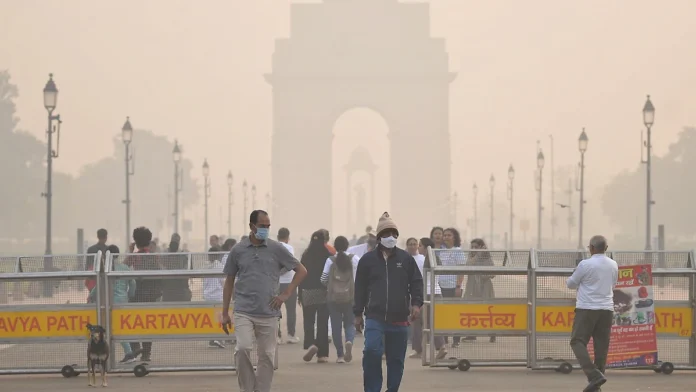Delhi’s air quality showed marginal improvement on Thursday, moving from the ‘severe’ category to ‘very poor’ after five consecutive days of hazardous pollution levels. The city remained enveloped in a toxic haze, with air quality indicators still far above safe limits, offering little respite to its residents. The shift, driven by light winds and changing weather conditions, was seen as a modest relief amid an otherwise grim situation.
Marginal Improvement in AQI Amid Persistent Toxicity
According to the Central Pollution Control Board (CPCB), Delhi’s Air Quality Index (AQI) dropped to 371 on Thursday from 418 recorded the previous day. Although this was a decline from the ‘severe’ level, the air quality remained firmly in the ‘very poor’ category. Notably, the AQI in several parts of the city continued to hover within the ‘severe’ range, underlining the persistent pollution crisis.
The gradual shift was attributed to light winds blowing at 6-8 kmph since Wednesday evening. By Thursday afternoon, the AQI recorded was 372, only a slight improvement from the morning’s 376. The slight drop was still insufficient to provide substantial relief, with the city’s PM2.5 levels oscillating between 168.5 and 196.8 micrograms per cubic metre—almost three times the national standard of 60 micrograms and far exceeding the World Health Organization’s (WHO) benchmark of 15 micrograms. Similarly, PM10 levels ranged between 289.6 and 321.3 micrograms per cubic metre, against the national standard of 100 units.

Surrounding Areas Show Mixed Results
While Delhi grappled with its toxic air, surrounding cities in the National Capital Region (NCR) exhibited slightly better air quality. Greater Noida recorded an AQI of 212, Noida stood at 253, Ghaziabad registered 291, Faridabad reported 320, and Gurgaon recorded 298. These numbers, though comparatively lower than Delhi, were still within the ‘very poor’ category.
The overall improvement in the region is expected to remain limited in the coming days. Experts from the India Meteorological Department (IMD) and IITM’s air quality early warning system predict that Delhi’s AQI will remain in the ‘very poor’ category from November 22 to November 24, with no significant improvement likely until after this period.
Weather Dynamics: A Double-Edged Sword
Mahesh Palwat, Vice Chairman of Climate Change and Meteorology at Skymet, explained the interplay of weather factors. “Dry westerly winds are expected to marginally reduce smog formation, but the low wind speed, coupled with falling temperatures, will hinder the dispersion of pollutants,” he said.
As the city’s mercury continues to drop, pollution is likely to stay trapped closer to the ground, exacerbating health risks. IMD forecasts indicate a potential temperature dip of 2-4 degrees Celsius in the next two days, with the minimum temperature on Thursday settling at 11°C, slightly higher than Wednesday’s 10.8°C. Despite this, temperatures across the northern plains remain higher than average for this time of year.
IMD has also withdrawn its ‘yellow alert’ for dense fog, noting a reduction in fog intensity. However, shallow haze and thin layers of smog persisted, further reducing visibility and air quality.
GRAP-IV Restrictions Continue Amid Crisis
In light of the persistent pollution crisis, stringent measures under the Graded Response Action Plan (GRAP) Stage IV remain in effect. These include a complete ban on construction and demolition activities, except for essential projects, and a prohibition on the entry of non-essential trucks into the city. Educational institutions have switched to online classes, and non-essential government offices are operating at 50% capacity.
The measures aim to curb the addition of particulate matter into the already polluted air. However, experts caution that these steps, while essential, cannot address the underlying issues of emissions from vehicular traffic, stubble burning, and industrial activities.
A Long Road Ahead
While Thursday’s slight improvement in AQI provided a glimmer of hope, the overall scenario remains bleak. The ventilation index—a measure of pollutant dispersal capacity—remains below the critical threshold of 6,000 m²/s, signaling unfavorable conditions for clearing pollutants from the air.
Health experts continue to warn residents about the adverse effects of prolonged exposure to such high levels of pollution. The city’s air quality crisis has reached a point where urgent, systemic changes are necessary, including stricter vehicular emission norms, better waste management practices, and enhanced green cover to absorb pollutants.

